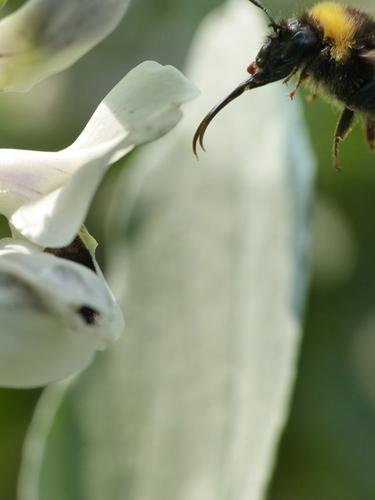当前位置:
X-MOL 学术
›
J. Appl. Ecol.
›
论文详情
Our official English website, www.x-mol.net, welcomes your
feedback! (Note: you will need to create a separate account there.)
Functional groups of wild bees respond differently to faba bean ( Vicia faba L.) cultivation at landscape scale
Journal of Applied Ecology ( IF 5.0 ) Pub Date : 2020-09-20 , DOI: 10.1111/1365-2664.13745 Nicole Beyer 1 , Doreen Gabriel 2 , Felix Kirsch 1 , Katharina Schulz‐Kesting 3, 4 , Jens Dauber 3, 4 , Catrin Westphal 1, 5
Journal of Applied Ecology ( IF 5.0 ) Pub Date : 2020-09-20 , DOI: 10.1111/1365-2664.13745 Nicole Beyer 1 , Doreen Gabriel 2 , Felix Kirsch 1 , Katharina Schulz‐Kesting 3, 4 , Jens Dauber 3, 4 , Catrin Westphal 1, 5
Affiliation

|
1. Concerns about insect declines are growing and the provisioning of ecosystem services like pollination may be threatened. To safeguard biodiversity, greening measures were introduced within the reform of the EU's Common Agricultural Policy. One measure commonly applied by farmers is the cultivation of nitrogen fixing crops. Although underlying studies are largely missing, this measure is criticized as providing no significant biodiversity benefit. 2. Using a landscape-scale approach, we selected 30 paired study landscapes (1 km × 1 km) in Germany, that is, 15 study landscapes with faba bean (FB) fields (Vicia faba L .) a nd 15 w ithout a ny g rain l egumes. F lower-visiting w ild b ees were recorded with transect walks at the field margins of different crops using a stratified sampling approach. We analysed the effect of FB cultivation and landscape composition on the abundance and species richness of wild bees as well as on the functional composition of the bee communities. 3. Bumblebee densities (Bombus spp. Latreille) were more than twice as high in FB compared to control landscapes after the flowering of the beans. Non-Bombus wild bee densities, however, were not affected by FB cultivation, but were enhanced by increasing amounts of semi-natural habitats (SNH). 4. After the beans' blooming had ceased, FB landscapes had a higher proportion of wild bees collecting pollen from Fabaceae than control landscapes. The communityweighted means for bee size, measured as intertegular distance, were not affected by FB cultivation, but we found smaller species and species with shorter tongues with an increasing percentage of SNH. 5. Synthesis and applications. The cultivation of faba bean Vicia faba L . s trongly increased bumblebee densities throughout the season. This indicates that also on-field greening measures can support biodiversity. Nevertheless, since only functional groups adapted to faba bean benefit, measures to promote seminatural habitats in agricultural landscapes need to be implemented. We conclude that the combination of on- and off-field measures is essential to maintain farmland biodiversity and the Common Agricultural Policy should furthermore promote both.
中文翻译:

野生蜜蜂功能群对景观尺度蚕豆(Vicia faba L.)种植的反应不同
1. 对昆虫数量减少的担忧日益加剧,授粉等生态系统服务的供应可能会受到威胁。为了保护生物多样性,欧盟共同农业政策的改革中引入了绿化措施。农民常用的一种措施是种植固氮作物。尽管基本研究基本缺失,但该措施被批评为没有提供显着的生物多样性益处。2. 使用景观尺度方法,我们在德国选择了 30 个成对的研究景观(1 公里 × 1 公里),即 15 个有蚕豆 (FB) 田 (Vicia faba L.) 的研究景观和 15 个没有纽约雨豆。使用分层抽样方法,在不同作物的田地边缘,通过样带走行记录了 F 较低的野生蜜蜂。我们分析了FB栽培和景观组成对野生蜜蜂的丰度和物种丰富度以及蜜蜂群落功能组成的影响。3. 与豆开花后的对照景观相比,FB 中的大黄蜂密度 (Bombus spp. Latreille) 高出两倍以上。然而,非 Bombus 野生蜜蜂的密度不受 FB 种植的影响,但由于半自然栖息地 (SNH) 数量的增加而增加。4.豆类开花停止后,FB景观比对照景观有更高比例的野生蜜蜂从豆科植物中采集花粉。蜜蜂大小的社区加权平均值(以间距测量)不受 FB 培养的影响,但我们发现较小的物种和舌头较短的物种,SNH 的百分比增加。5. 合成与应用。蚕豆的栽培 蚕豆。整个季节大黄蜂的密度大大增加。这表明现场绿化措施也可以支持生物多样性。然而,由于只有适应蚕豆的功能群体才能受益,因此需要采取措施促进农业景观中的半自然栖息地。我们得出结论,田间和田间措施的结合对于保持农田生物多样性至关重要,共同农业政策应进一步促进两者。需要采取措施促进农业景观中的半自然生境。我们得出的结论是,田间和田间措施的结合对于保持农田生物多样性至关重要,共同农业政策应进一步促进这两者。需要采取措施促进农业景观中的半自然生境。我们得出结论,田间和田间措施的结合对于保持农田生物多样性至关重要,共同农业政策应进一步促进两者。
更新日期:2020-09-20
中文翻译:

野生蜜蜂功能群对景观尺度蚕豆(Vicia faba L.)种植的反应不同
1. 对昆虫数量减少的担忧日益加剧,授粉等生态系统服务的供应可能会受到威胁。为了保护生物多样性,欧盟共同农业政策的改革中引入了绿化措施。农民常用的一种措施是种植固氮作物。尽管基本研究基本缺失,但该措施被批评为没有提供显着的生物多样性益处。2. 使用景观尺度方法,我们在德国选择了 30 个成对的研究景观(1 公里 × 1 公里),即 15 个有蚕豆 (FB) 田 (Vicia faba L.) 的研究景观和 15 个没有纽约雨豆。使用分层抽样方法,在不同作物的田地边缘,通过样带走行记录了 F 较低的野生蜜蜂。我们分析了FB栽培和景观组成对野生蜜蜂的丰度和物种丰富度以及蜜蜂群落功能组成的影响。3. 与豆开花后的对照景观相比,FB 中的大黄蜂密度 (Bombus spp. Latreille) 高出两倍以上。然而,非 Bombus 野生蜜蜂的密度不受 FB 种植的影响,但由于半自然栖息地 (SNH) 数量的增加而增加。4.豆类开花停止后,FB景观比对照景观有更高比例的野生蜜蜂从豆科植物中采集花粉。蜜蜂大小的社区加权平均值(以间距测量)不受 FB 培养的影响,但我们发现较小的物种和舌头较短的物种,SNH 的百分比增加。5. 合成与应用。蚕豆的栽培 蚕豆。整个季节大黄蜂的密度大大增加。这表明现场绿化措施也可以支持生物多样性。然而,由于只有适应蚕豆的功能群体才能受益,因此需要采取措施促进农业景观中的半自然栖息地。我们得出结论,田间和田间措施的结合对于保持农田生物多样性至关重要,共同农业政策应进一步促进两者。需要采取措施促进农业景观中的半自然生境。我们得出的结论是,田间和田间措施的结合对于保持农田生物多样性至关重要,共同农业政策应进一步促进这两者。需要采取措施促进农业景观中的半自然生境。我们得出结论,田间和田间措施的结合对于保持农田生物多样性至关重要,共同农业政策应进一步促进两者。











































 京公网安备 11010802027423号
京公网安备 11010802027423号